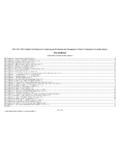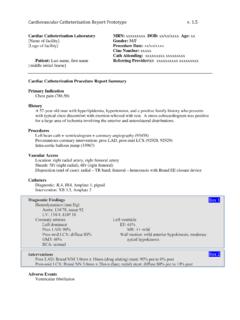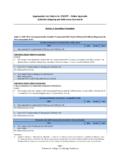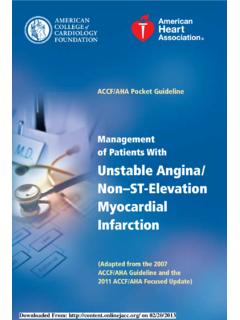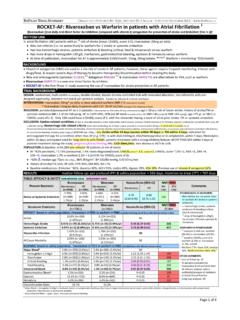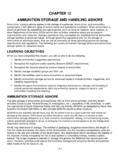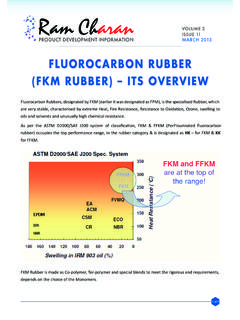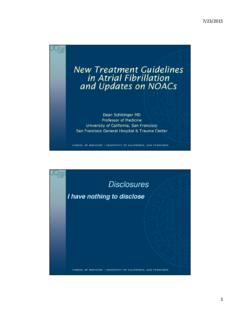Transcription of 2014 AHA/ACC/HRS Atrial Fibrillation Guideline Data ...
1 American College of Cardiology Foundation and American Heart Association, Inc. 1 2014 AHA/ACC/HRS Atrial Fibrillation Guideline Data Supplements (Section numbers correspond to the full-text Guideline .) Table of Contents Data Supplement 1. Electrophysiologic Mechanisms in the Initiation and Maintenance of AF (Section 2) .. 2 Data Supplement 2. Pathophysiologic Mechanisms Generating the AF Substrate (Section 2) .. 2 Data Supplement 3. Oral Anticoagulants (Dabigatran, Rivaroxaban, Apixaban) vs. Warfarin (Section ).
2 3 Data Supplement 4. Warfarin vs. Control (Section ) .. 6 Data Supplement 5. Warfarin vs. Antiplatelet Therapy (Section ) .. 7 Data Supplement 6. Beta Blockers (Sections ) .. 9 Data Supplement 7. Nondihydropyridine Calcium Channel Blockers (Sections ) .. 10 Data Supplement 8. Digoxin (Sections ) .. 11 Data Supplement 9. Other Pharmacological Agents for Rate Control (Sections ) .. 12 Data Supplement 10. AV Junction Ablation (Sections ) .. 13 Data Supplement 11. Broad Considerations in Rate Control (Sections ) .. 13 Data Supplement 12.
3 Antiarrhythmic Drug Therapy (Section ) .. 14 Data Supplement 13. Outpatient Initiation of Antiarrhythmic Drug Therapy (Section ) .. 24 Data Supplement 14. Upsteam Therapy (Section ) .. 25 Data Supplement 15. AF Catheter Ablation to Maintain Sinus Rhythm (Section ) .. 27 Data Supplement 16. Meta-Analyses and Surveys of AF Catheter Ablation (Section ) .. 30 Data Supplement 17. Specific Patient Groups (Section 7) .. 31 References .. 37 American College of Cardiology Foundation and American Heart Association, Inc. 2 Data Supplement 1.
4 Electrophysiologic Mechanisms in the Initiation and Maintenance of AF (Section 2) Mechanism References Experimental Human Multiple wavelet hypothesis (1-3) (4-8) Heterogeneity in Atrial electrophysiology (3, 9) (10-13) Focal firing (14-17) (18-21) Pulmonary vein foci o Electrophysiology (16, 22-28) (29, 30) o Evidence for reentry (24, 31-33) (30, 34-36) o Evidence for focal firing (32) (35) Nonpulmonary vein foci (17) (19, 21, 37-42) Rotor with fibrillatory conduction (9, 31-33, 43-46) (34-36, 47-50) Dominant frequency gradients (9, 32, 43, 46, 51) (34, 49-52) AF indicates Atrial Fibrillation .
5 Data Supplement 2. Pathophysiologic Mechanisms Generating the AF Substrate (Section 2) Mechanism References Experimental Human Atrial structural abnormalities (9, 53-55) (56-62) Fibrosis (63-70) (55, 56, 62, 63, 71-73) Noninvasive imaging of fibrosis (74, 75) (76-79) Inflammation/oxidative stress (80-83) (59, 80, 82-88) Steroids (89-91) N/A Statins (92-94) N/A Omega-3 polyunsaturated fatty acids (95-100) (96, 101-103) Renin-angiotensin-aldosterone system activation (104-114) (72, 115, 116) Aldosterone (117, 118) (119-121)
6 Transforming growth factor- 1 (68, 122, 123) N/A Autonomic nervous system (3, 14-16, 27, 124-126) (127-129) Genetic variants See Section Atrial tachycardia remodeling Electrophysiologic (9, 130-136) (137, 138) Structural (53, 132, 139-142) N/A Intracellular calcium (143-145) (145-148) Extracardiac factors See Section AF indicates Atrial Fibrillation . American College of Cardiology Foundation and American Heart Association, Inc. 3 Data Supplement 3. Oral Anticoagulants (Dabigatran, Rivaroxaban, Apixaban) vs.
7 Warfarin (Section ) Study Name, Author, Year Study Aim Study Type/Size (N) Intervention vs. Comparator (n) Patient Population Study Intervention Endpoints P Values, OR: HR: RR: & 95% CI: Adverse Events Study Limitations Inclusion Criteria Exclusion Criteria Primary Endpoint & Results Safety Endpoint & Results Secondary Endpoint & Results RE-LY Randomized Connolly SJ, et al., 2009 (149) 19717844 To compare 2 fixed doses of dabigatran with open-label use of warfarin in pts with AF at increased risk of stroke RCT, open-label, blinded doses of dabigatran (18,113) Dabigatran 110 mg (6,015) Dabigatran 150 mg (6,076) Warfarin (6,021) AF and 1 of the following: prior stroke or TIA.
8 LVEF<40%, NYHA class II or higher HF Sx, age 75 y or an age of 65-74 y plus DM, HTN, or CAD Mean CHADS2 of Severe heart-valve disorder, stroke within 14 d or severe stroke within 6 mo, condition that increased hemorrhage risk, CrCl <20 mL/min, active liver disease, pregnancy Dabigatran in 2 fixed doses oral prodrug, direct competitive inhibitor of thrombin Warfarin INR 2-3, mean TTR 64% Stroke or SE Dabigatran110 mg Dabigatran 150 mg Warfarin Major Hemorrhage Dabigatran 110 mg Dabigatran 150 mg Warfarin Intracranial Bleeding Dabigatran 110 mg Dabigatran 150 mg Warfarin Major GI Stroke Dabigatran 110 mg Dabigatran 150 mg Warfarin Stroke, ST elevation, PE, MI, death, or major bleeding Dabigatran 110 mg Dabigatran 150 mg Warfarin Dabigatran 110 mg RR: ; 95% CI.
9 P< for noninferiority, p= for superiority Dabigatran 150 mg RR: ; 95% CI: ; p< for noninferiority, p< for superiority Dyspepsia Open-label Median duration of FU 2 y American College of Cardiology Foundation and American Heart Association, Inc. 4 Dabigatran 110 mg Dabigatran 150 mg Warfarin ROCKET-AF Patel MR, et al., 2011 (150) 21830957 To compare QD oral rivaroxaban with dose-adjusted warfarin for the prevention of stroke and SE in pts with NVAF who were at moderate to high risk of stroke RCT, double-dummy, double-blinded (14,264) Rivaroxaban (7,131) Warfarin (7,133) NVAF at moderate to high risk of stroke.
10 Hx of stroke, TIA, or SE or 2 of the following (HF or LVEF<35%, HTN, age >75 y, DM (CHADS2 score of 2) Mean CHADS2 score of Severe valvular disease, transient AF caused by a reversible disorder, hemorrhage risk related criteria; severe, disabling stroke within 3 mo or any stroke within 14 d, TIA within 3 d; indication for anticoagulant Tx Rivaroxaban Factor Xa inhibitor, 20 mg QD or 15 mg QD for those with CrCl of 39-40 mL/min Warfarin INR 2-3, mean TTR 55% Any stroke or SE Per-protocol as treated Rivaroxaban Warfarin Intention to Treat Rivaroxaban Warfarin Major and non-major clinically relevant bleeding Rivaroxaban pt-years Warfarin pt-years ICH Rivaroxaban pt-years Warfarin pt-years Major GI Rivaroxaban Warfarin Stroke, SE, or VD Rivaroxaban pt-years Warfarin pt-years HR.)
